




Acknowledgments
PROJECT
Dennis Carson City of Lafayette
Scott Feller Montgomery County
Kim Kalweit Fountain County
Tetia Lee The Arts Federation
Latisha Provo Benton County
Randy Strasser White County
Shannon Telfer Carroll County DESIGNING
Josh Lapp
Gabrielle Smith

The Greater Lafayette READI Region is made up of seven counties in West Central Indiana: Benton, Carroll, Fountain, Montgomery, Tippecanoe, Warren, and White. The Wabash River cuts through the middle of the region, creating many opportunities for dynamic waterfront developments. The region varies dramatically in population, containing both one of the largest counties by population in Indiana (Tippecanoe) and two of the smallest (Benton and Warren). Much of the region is rural with an agricultural landscape, with the exception of the cities of Lafayette and West Lafayette, though other small towns and communities provide more localized centers for arts and culture for residents.
Region Population
302,819 Land Area
3,048 m 2
Land Area: 406.4 m^2
County Population: 8,719
Population Growth: -1.5%
County Median Age: 40.3

• Benton County Fair
County Median HHI: $61,811
# Employers: 176
Employment Rate: 59.5%
2020 Census
Benton County is one of the smallest counties by population in the state of Indiana. It is located in the Northwestern corner of the GLRR, bordered by White County to the east, Tippecanoe County to the southeast, and Warren County to the south. Its county seat, Fowler, is home to roughly a quarter (2,337) of this population. While the county is home to a strong public library system, downtown Fowler houses the Fowler Theater, which is a valuable community arts and culture asset that provides experiences for all ages.
• Boswell Harvest Music Festival
• Boswell Street Festival
• Christkindl on the Square & Tree Lighting
• Dan Patch Days Community Festival
• Discover Oxford Farmers Market
• Earl Park Fall Festival
• Fowler 4th of July Festival
• Fowler Christmas Stroll
• Heritage House Garden Tour
• Otterbein Street Festival
• Patch Party Music Festival




Land Area: 372.2 m^2
County Population: 18,985
Population Growth: .7%
County Median Age: 49.2

Life
• Annual Hog Jog Flora
• Annual Old Settlers Festival
• Burlington Christmas Walk
• Burlington Fall Festival
• Camden’s Fall Festival
• Canal Days Festival
County Median HHI: $64,003
# Employers: 388
Employment Rate: 60.4%
2020 Census
Carroll County is located in the Northeastern corner of the GLRR, bordered by White County to the northwest, and Tippecanoe County to the southwest. Its county seat and only city, Delphi, has a population of 2,961, roughly 16% of the county population. Carroll County has a strong rural character and rich heritage, rooted in preserving historical places, natural resources, and artistic expression. The Delphi Opera House is a performing arts venue that hosts local and regional talent, and is a vital anchor in the active arts and culture community. The Wabash & Erie Canal Park and Interpretive Center attract visitors with its narrated trail walks and canal boat rides. The Canal Days festival, a unique family-friendly community staple, in addition to the historically significant Old Settlers Festival, and most recently, the Indiana Bacon Festival, all provide community members and visitors alike lively arts and cultural experiences and events throughout the year.
• Carroll County 4H Fair and Parade
• Cutler Collage
• Delphi 4th of July Parade (Lions Club Parade)
• Delphi Christmas Parades
• Delphi Farmers Market
• Delphi Hispanic Festival
• Flora Christmas Parade
• Flora Depot Day Festival
• Flora Farmers Market
• Flower & Garden Show of Carroll County
• Helping Hands Fest
• Indiana Bacon Festival


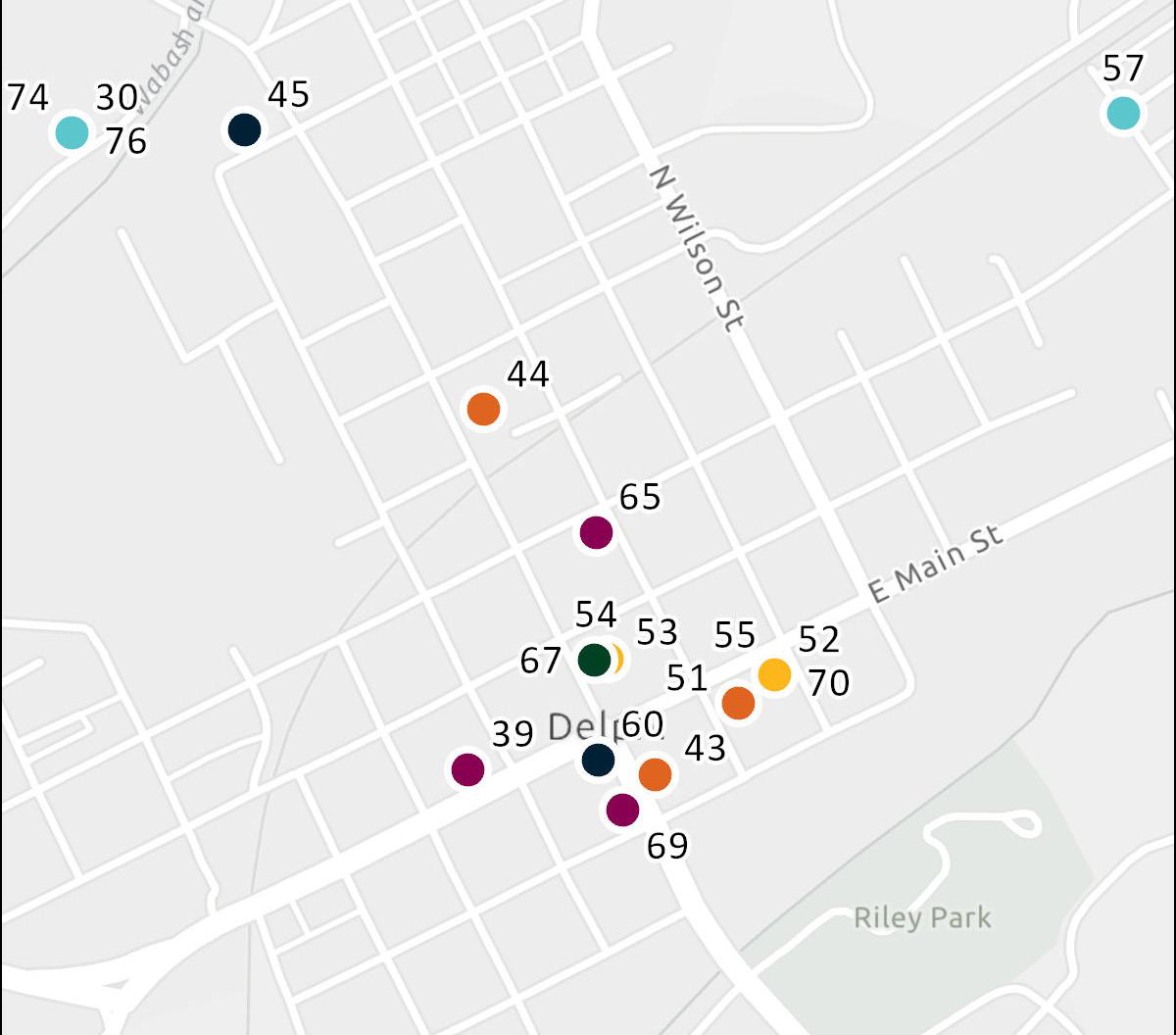
Wabash & Erie Canal Conference & Interpretive Center
Center Stage Dance Academy
Delphi Opera House Inc
The Red Brick Theater
Bicentennial Mounment
Delphi Founders Mural
Farmer Mural
Flora Murals 2 (Daylily and Ironman)
Springs to Life Mural
Opera House Gallery of Contemporary Art
Org. without Brick and Mortar
Land Area: 395.7 m^2

Fountain County, located in the southwestern corner of the GLRR, is bordered by Warren County to the northwest, Tippecanoe County to the northeast, and Montgomery County to the southeast. Covington serves as the county seat, with a population of 2,668, which constitutes 16% of the county’s total population. Deeply rooted in its agricultural heritage and rural charm, Fountain County benefits from a strong public library system that is integral to bringing arts and culture to the community. The Fountain County Courthouse in Covington, an Art Deco building listed on the National Register of Historic Places, showcases over 2,500 square feet of historic murals inside. Furthermore, the annual Attica Heritage Days festival celebrates local culture, featuring arts and crafts vendors, live music, and parades.
• Attica Dancing in the Streets
• Attica Heritage Days
• Covington 4th of July at the Park
• Covington Apple Fest
• Covington Street Fest
• Veedersburg Cruise-In
• Veedersburg Street Fair
• Veedersburg Summer Sounds Series


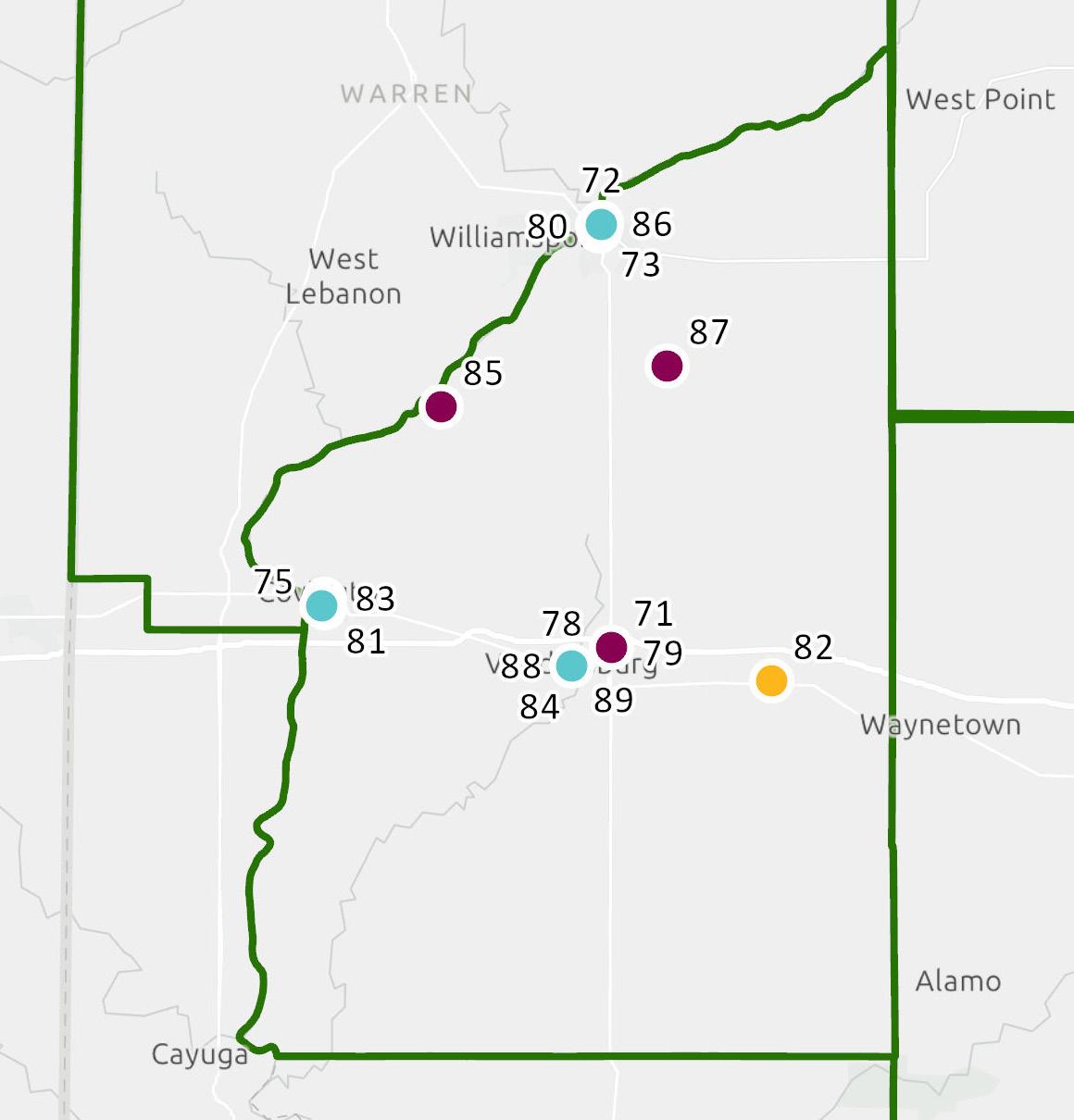

Cultural Amenities
71 Attica Downtown Historic District
72 1853 Revere Hotel
73 Attica Public Library
77 Covington Public Library
78 d'Arlier Cultural Center
83 Fountain County Courthouse
85 Portland Arch Nature Preserve
87 Rob Roy Covered Bridge
89 Veedersburg Public Library
Museums
81 Fountain County Clerk's Building & Museum
Performing Arts
80 Devon Theatre
82 Myer's Dinner Theatre
Public Art
75 Covington Mural
84 Peonies Mural
86 Summer Night/Attica Registered Mural
88 Veedersburg Mural
Arts Org. without Brick and Mortar
Friends of the Covington Public Library

Land Area: 504.6 m^2
County Population: 37,936
Population Growth: -.5%
County Median Age: 40.0
County Median HHI: $66,571 # Employers: 847
Employment Rate: 60.9%
2020 Census
Montgomery County, the southernmost county in the GLRR, is bordered by Tippecanoe County to the north and Fountain County to the northwest. Its county seat, Crawfordsville, comprises 43% of the county’s population. Montgomery County is a rich, vibrant community, featuring unique arts and cultural assets, outdoor recreation, and historic amenities. It is also home to Wabash College. From the Carnegie Museum to the Ironman Raceway and the Green Street Gallery, Montgomery County boasts a diverse and exciting cultural tapestry. Events like First Fridays, Oktoberfest, and the Crawfordsville Strawberry Festival ensure the community has fun and exciting opportunities to experience arts and culture locally.
FESTIVALS AND EVENTS
• Christmas Parade
• Crawfordsville Art Walk
• Crawfordsville Strawberry Festival
• Downtown Party Night
• Festival of Trees
• First Fridays
• Ironman National
• Midwest Railroad Fair
• Oktoberfest
• Pike Place Free Summer Concerts
• Small Business Saturday
• Sugar Creek Canoe Race
• Taste of Montgomery County



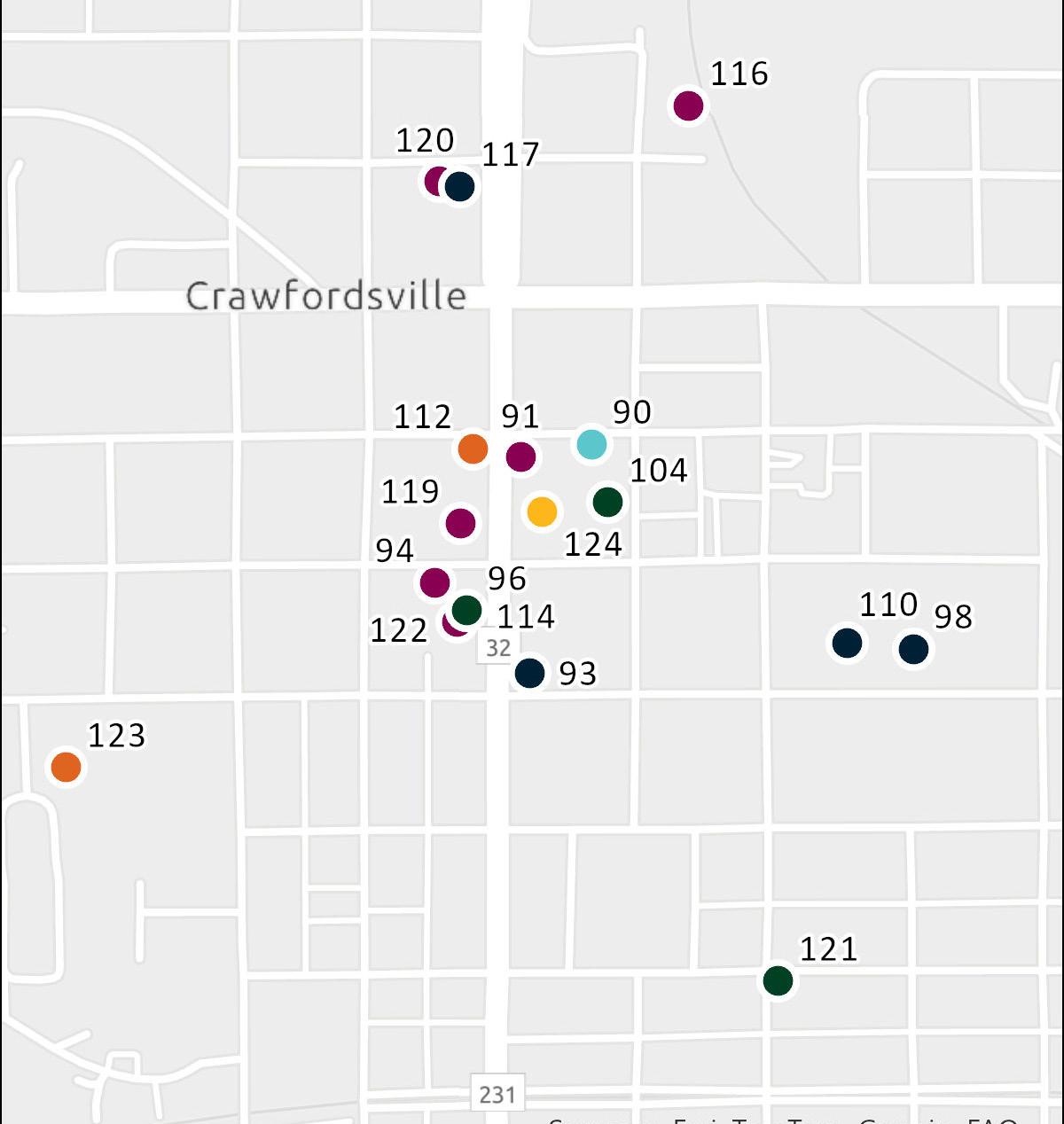

Land Area: 498.9 m^2
County Population: 186,251
Population Growth: 7.8%
County Median Age: 29.0
County Median HHI: $60,762
# Employers: 3,664
Employment Rate: 63.7%
2020 Census
Tippecanoe County, the most populous county in the GLRR, is centrally located within the region, bordered by Montgomery County to the south, White County to the north, Carroll County to the northeast, Warren County to the west, Benton County to the northwest, and Fountain to the southwest. Lafayette, the county seat and largest city in the GLRR, has a population of 70,783, which is roughly 38% of the county population. As a key cultural center in Indiana, Tippecanoe County features a thriving Arts and Cultural District in Lafayette-West Lafayette, home to assets like the Art Museum of Greater Lafayette, The Long Center for Performing Arts, the Civic Theatre of Greater Lafayette, and The Arts Federation (TAF), which supports regional arts. The county offers numerous galleries, performance spaces, and a robust, vibrant festival calendar. Notable events include the Taste of Tippecanoe, Mosey Down Main Street, and the historic Feast of the Hunters’ Moon, all contributing to a rich artistic landscape and community engagement.
• A Merry Main Street Market
• Art in the Park
• Art on the Wabash
• Beers Across the Wabash
• Downtown Blues and Jazz Festival
• Feast of the Hunters’ Moon
• Gallery Walk
• Global Fest
• Greater Lafayette Christmas Parade
• Indiana Fiddlers’ Gathering, Inc.
• Lafayette Farmers Market
• Mosey Down Main Street
• Outfest
• Purdue Boilermaker HalfMarathon & 5-K
• Purdue Christmas Show
• Purdue Farmers Market
• Purdue Grand Prix
• Purdue Homecoming
• Purdue Spring Fest
• Purdue Summer Concert Series
• Round the Fountain Art Fair
• St. Boniface Germanfest
• Star City Nights Festival
• Stars & Stripes Celebration
• Summer on the Square
• Tap for TAF
• Taste of Tippecanoe
• Tippecanoe County 4-H Fair
• Tippecanoe Latino Festival
• Wabash Riverfest
• West Lafayette Farmers Market
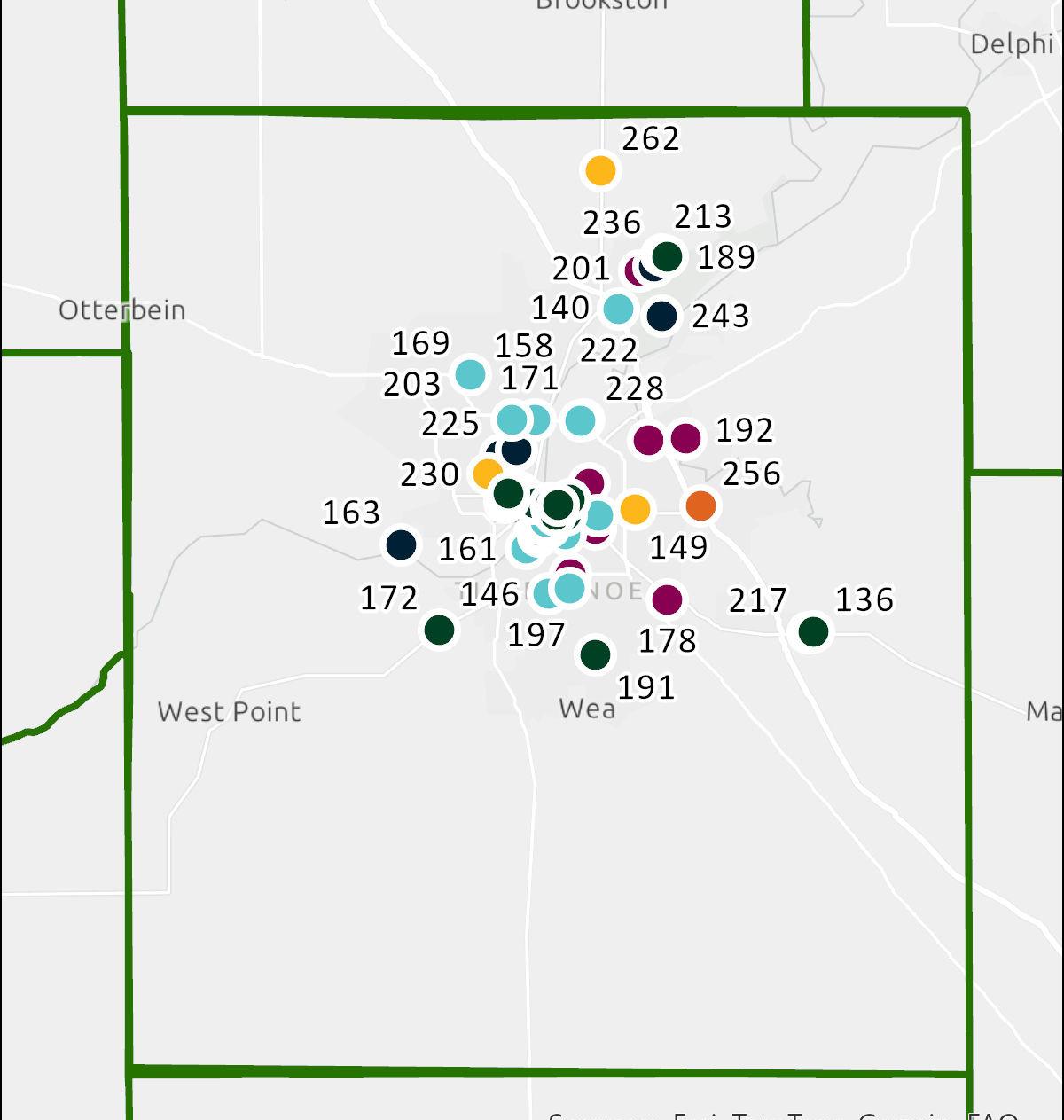

Tippecanoe County Lafayette

West Lafayette
Arts Supporting Org.
188 Main Street Books
224 Second Flight Books
236 The Arts Federation
240 The Bookland
256 Visit Lafayette - West Lafayette
Cultural Amenities
128 Arganbright Genealogy Center and the Tippecanoe County Historical Association
135 Big Four Depot Building
139 Clegg Memorial Garden
142 Colorful Rebirth Mural
143 Columbian Park Memorial Island Amphitheater
144 Columbian Park Zoo
157 Flourish Studio and Classroom
158 Elliott Hall of Music
162 Historic Downtown Lafayette
169 Jules Janick Horticulture Garden
176 Lafayette Aviators - Loeb Stadium
178 Lafayette Family YMCA
181 Latino Center for Wellness and Education
182 Lafayette Farmers Market
192 NICHES Land Trust
200 Purdue Arboretum
201 Prophet's Rock
203 Purdue Asian American and Asian Resource and Cultural Center
204 Purdue Bell Tower
205 Purdue Latino Cultural Center
206 Purdue Convocations
207 Purdue Lesbian, Gay, Bisexual, Transgender and Queer (LGBTQ) Center
208 Purdue Black Cultural Center
209 Purdue Native American Education and Cultural Center
210 Purdue University
216 Riverfront - Riehle Plaza, Riverside Promenade Deck and John T. Myers Pedestrian Bridge
218 Riverside Skating Center 219 Riehle Plaza 234 Tapawingo Park and Wabash Heritage Trail 247 The Weather Station 249 Tippecanoe County Fairgrounds 250 Tippecanoe County Courthouse
261 Wells Community Cultural Center 263 West Lafayette Public Library 266 Wabash Landing 9
Museums
155 Five Points Fire Station Museum 163 Fort Ouiatenon Historic Park 164 Haan Museum of Indiana Art
Imagination Station
SAMARA 243 The Farm at Prophetstown
Tippecanoe Battlefield & Museum
245 The Caretaker's Cottage 251 Tippecanoe County Historical Association
Performing Arts
141 Civic Theatre of Greater Lafayette 149 Dance Magic 166 Historic Monon Depot Theatre
177 Lafayette Ballet Company 179 Lafayette Master Chorale 180 Lafayette Symphony Orchestra 183 Lafayette Theater 184 Loeb Playhouse
186 Long Center for the Performing Arts 211 Purdue Theatre
213 Rec Room Recording
214 Purdue University Division of Dance
230 Slayter Center for the Performing Arts
246 Thomas Duncan Community Hall, Inc.
248 Tippecanoe Chamber Music Society
262 Tippecanoe County Amphitheater
269 Yue-Kong Pao Hall of Visual & Performing Arts
Public Art
125 Abstract Mural
126 (Dis)connect Mural
130 Asylum Seeker Mural
137 Book of Imagination Mural
138 Cat Lady Mural
140 Blue Sky Mural
145 Conductor Bear Mural
146 Dogwood Mural
147 Diversity Mural
148 Common Milkweed
151 Fiddle Mural
152 Escape Darkness, Breaking Chains Mural
153 Ephemeral/robots Mural
154 Firefly Mural
156 Fox and Echinacea Mural
160 Gatekeeper Mural
161 Help the World Thrive Mural
165 Hot Pursuit Mural
168 Inner Alley Symphony Mural
170 Jazz Action Heroes Murals
171 Indiana Energy Mural
173 Ladybugs Mural
185 Monarch Wings Mural
187 Love Bear Mural
190 Movement/Ta Mural
193 Nature Views Mural
194 Mythic Wabash Mural
195 Play Music Everywhere Mural
196 Peacock Mural
198 Playhouse Mural
202 Purdue Bear Mural
212 Quest Mural
217 Red Bird Cafe Mural
221 Rose Mural
222 Reaching New Heights Mural
223 Rose for Jimmy Mural
226 Second Flight Mural
227 Separation Anxiety Mural
228 Seen Mural
229 Six Panels Make One Wall Mural
231 Slide Down Mural
233 Seek Mural
235 Small Spaces Mural
238 Slide Thru Mural
239 Stay Golden Mural
241 The Morning Sun Mural
242 The Sound of Nature Mural
252 Town Mouse and Country Mouse Mural
253 Together Mural
254 Universal Power Mural
255 Two Cities Mural
257 Wabash Avenue: Past and Present Mural
259 Wabash Heritage Mural
260 Wabash Walls Mural
264 Where Clouds Roam Mural
265 Women Mural
267 Zitkala-Sa Mural
268 You Are Loved Mural
Visual Arts
127 All Wined Down
131 Artists' Own
132 All Fired Up
133 Beyond Gallery & Gift Shop
134 Art Museum of Greater Lafayette
136 Brandon C. Bass Art Studio & Gallery
150 Edna the Glass Artist
172 Inspired Fire Glass Studio & Gallery
175 KL Art Gallery
189 Muddog Pottery / Indiana Clay
191 Painting With a Twist
199 Patti and Rusty Rueff Galleries
215 Purdue University Galleries
220 Robert L. Ringel Gallery, Stewart Center
237 The Arts Federation Galleries
Arts Org. without Brick and Mortar
General de Lafayette DAR
Lafayette Citizens Band
Pride Lafayette
Songwriters Association of MidNorth Indiana Wabash Valley Youth Symphony



Land

• (de)-fi Fest
Warren County, the smallest by population in the GLRR and one of Indiana’s most rural counties, is located on the western edge of the region. It is bordered by Benton County to the north, Fountain County to the south, and Tippecanoe County to the east. Its county seat, Williamsport, has a population of 1,950. Reflecting its rural nature, local historical societies, libraries, and natural resources are central to the community’s arts and culture programming. The county’s cultural landscape is anchored by landmarks like Williamsport Falls. Its proximity to larger cultural centers enhances access, while local fairs and seasonal gatherings highlight homegrown artisans, musicians, and performers, showcasing a strong community-driven cultural scene.
• Illiana Antique Power Association’s Annual Show


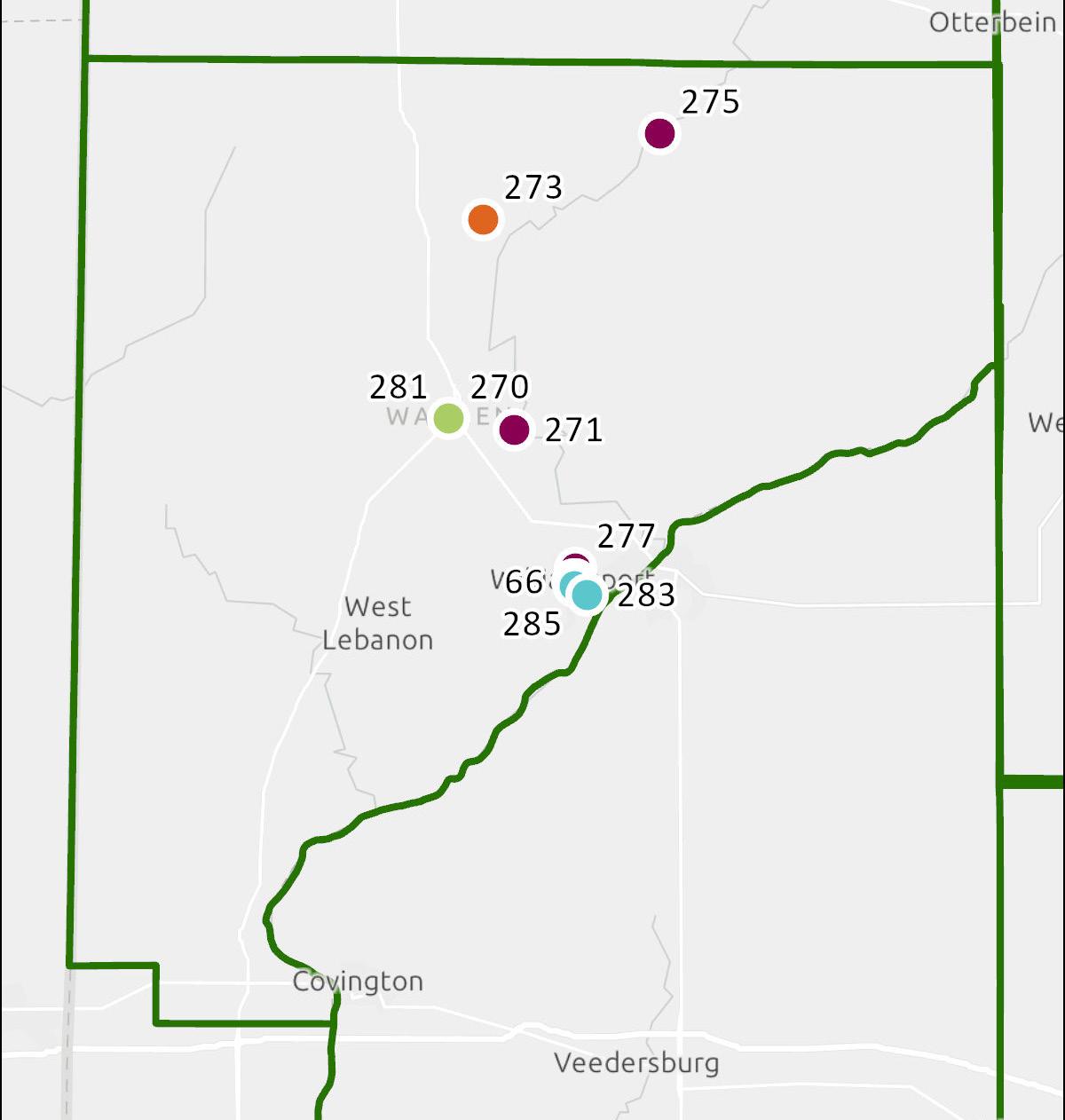

Arts Supporting Org.
273 Illiana Antique Power Association, Inc.
274 MSD of Warren County
276 Warren County Common Ground Coffee
278 Warren County Community Foundation
280 Warren County Local Economic Development Organization
282 Warren County Local Economic Development Organization
Cultural Amenities
66 Martin Schoolhouse
271 Fall Creek Gorge
275 Stalph
277 Warren County Fairgrounds
284 Warren County Learning Center
285 Williamsport Falls
287 West Lebanon-Pike Township Public Library
288 Williamsport-Washington Township Public Library
Museums
279 Warren County Historical & Genealogical Society Museum
Public Art
272 Gold Mural
283 Nature Is Surreal Mural
Arts Org. without Brick and Mortar
Grow Local
Warren Piece Friends
Land Area: 406.4 m^2 County Population: 8,719 Population Growth: -1.5% County

FESTIVALS AND EVENTS
• 4th of July Boat Parade
White County is the northernmost county in the GLRR. It is bordered by Tippecanoe County to the south, Carroll County to the southeast, and Benton County to the southwest. With Monticello as its county seat and a population of approximately 5,508, White County’s cultural scene is both historic and exciting. The county is home to popular attractions like the Indiana Beach Amusement and Water Park and the historic Lake Shore DriveIn Theatre. Its arts and culture landscape is further enriched by community organizations such as the Streets of Monticello Association and Monticello Arts Beat. Residents and visitors can also enjoy annual events including the Apple Popcorn Festival in Brookston and the Spirit of Monticello festival, as well as a popular Lighted Christmas Parade.
• Brookston Apple Popcorn Festival
• Buffalo Daze and Car Show
• Burnettsville Community Day
• Chalmers Days Festival & Cruise In
• Hops & Coaster Drops
• S.O.M.A. Ice Cream Social
• Idaville Truck & Tractor Pull
• Jingle & Mingle Christmas Event
• Monon Food Fest
• Monticello Farmers Market
• Spirit of Monticello Festival
• S.O.M.A We Love Our Downtown Event
• White County 4H Fair
• Wine & Wheels
• Wolcott Summer Country Gospel Music Series
• Wolcott Summer Festival




Arts Supporting Org.
293 Community Foundation of White County
299 Crasian Brewing Company
316 Whyte Horse Winery
Cultural Amenities
286 Bluestem Nature Center
290 Camp Buffalo
291 Constitution Plaza
292 Brookston-Prairie Township Public Library
297 Indiana Beach
300 Madam Carroll
306 Monon Town & Township Public Library
308 Monticello Tornado Memorial
311 Monticello Union Township Public Library
314 White County Council & Aging Senior Center
317 Wolcott Public Library
Museums
294 Historic Wolcott House
303 Monon Connection Museum
304 Monon Civic Center
315 White County Historical Society & Museum
Performing Arts
295 Dance Magic
305 Monon Theatre
Public Art
289 Cardinal Mural
298 Lost & Found Mural
302 Monon Railroad Mural
309 Monticello Union Township
Public Library Mural
310 The Window Mural
313 Wind Turbine Mural
Visual Arts
296 Lake Shore Drive-In
312 The Peacock Theatre
Arts Org. without Brick and Mortar
Monon Civic Preservation Society Streets of Monticello Association
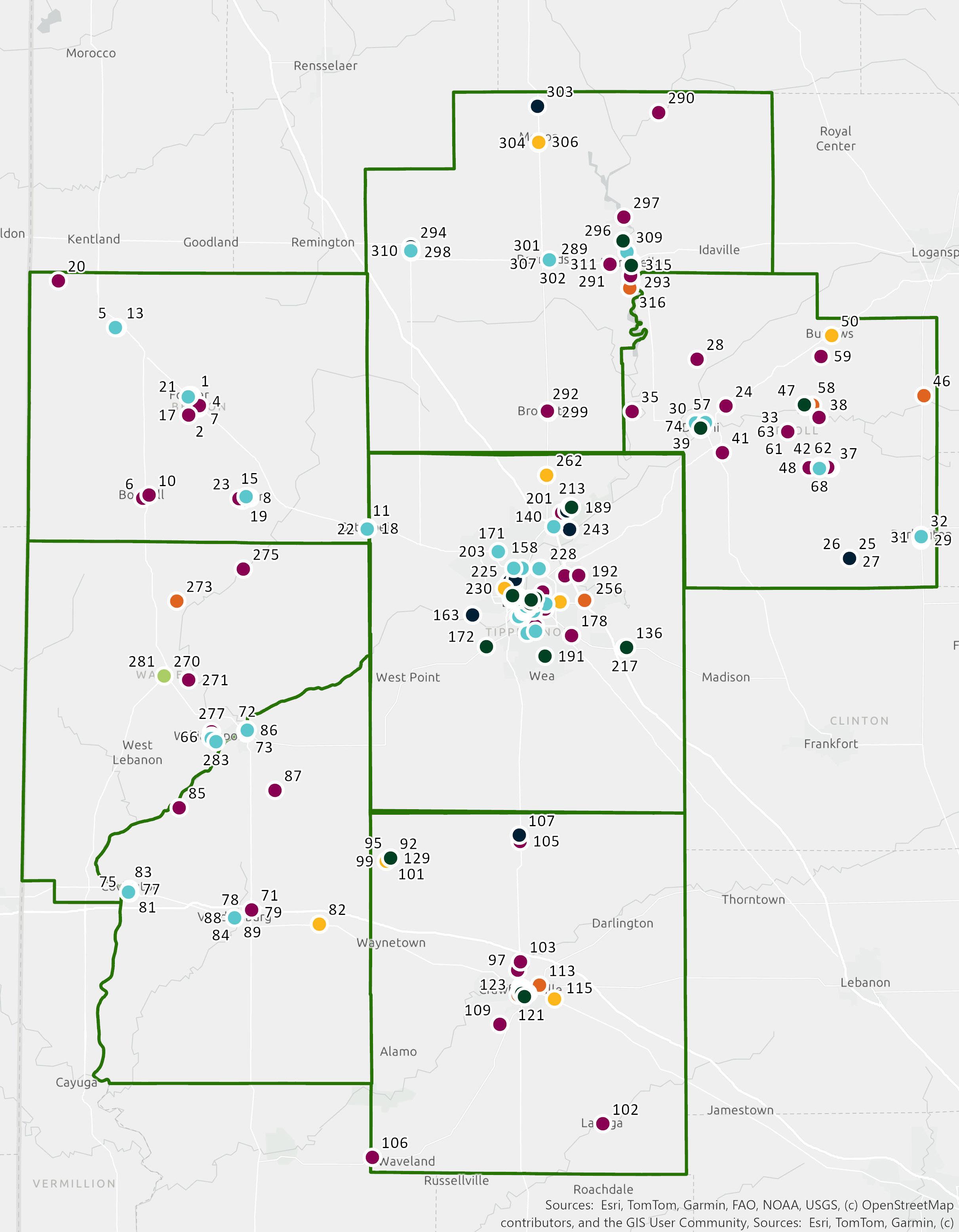
120 Tannenbaum Cultural Center
122 The Masonic Cornerstone Grand Hall & Event Center
128 Arganbright Genealogy Center and the Tippecanoe County Historical Association
135 Big Four Depot Building
139 Clegg Memorial Garden
142 Colorful Rebirth Mural
143 Columbian Park Memorial Island Amphitheater
144 Columbian Park Zoo
157 Flourish Studio and Classroom
158 Elliott Hall of Music
162 Historic Downtown Lafayette
169 Jules Janick Horticulture Garden
176 Lafayette Aviators - Loeb Stadium
178 Lafayette Family YMCA
181 Latino Center for Wellness and Education
182 Lafayette Farmers Market
192 NICHES Land Trust
200 Purdue Arboretum
201 Prophet's Rock
203 Purdue Asian American and Asian Resource and Cultural Center
204 Purdue Bell Tower
205 Purdue Latino Cultural Center
206 Purdue Convocations
207 Purdue Lesbian, Gay, Bisexual, Transgender and Queer (LGBTQ) Center
208 Purdue Black Cultural Center
209 Purdue Native American Education and Cultural Center
210 Purdue University
216 Riverfront - Riehle Plaza, Riverside Promenade Deck and John T. Myers Pedestrian Bridge
218 Riverside Skating Center
219 Riehle Plaza
234 Tapawingo Park and Wabash Heritage Trail
247 The Weather Station
249 Tippecanoe County Fairgrounds
250 Tippecanoe County Courthouse
261 Wells Community Cultural Center
263 West Lafayette Public Library
266 Wabash Landing 9
271 Fall Creek Gorge
275 Stalph
277 Warren County Fairgrounds
284 Warren County Learning Center
285 Williamsport Falls
286 Bluestem Nature Center
287 West Lebanon-Pike Township Public Library
288 Williamsport-Washington Township Public Library
290 Camp Buffalo
291 Constitution Plaza
292 Brookston-Prairie Township Public Library
297 Indiana Beach
300 Madam Carroll
306 Monon Town & Township Public Library
308 Monticello Tornado Memorial
311 Monticello Union Township Public Library
314 White County Council & Aging Senior Center
317 Wolcott Public Library
Museums
25 Adams Mill
27 American House Stagecoach Museum
45 Carroll County Historical Society & Museum
60 Flora Depot
74 Wabash & Erie Canal Conference & Interpretive Center
81 Fountain County Clerk's Building & Museum
93 Carnegie MuseumMontgomery
98 Dorothy Q Chapter, NSDAR Historic Chapter House
100 General Lew Wallace Study & Museum
107 Linden Depot Museum
110 Lane Place
117 Rotary Jail Museum
155 Five Points Fire Station Museum
163 Fort Ouiatenon Historic Park
164 Haan Museum of Indiana Art
167 Imagination Station
225 SAMARA
243 The Farm at Prophetstown
244 Tippecanoe Battlefield & Museum
245 The Caretaker's Cottage
251 Tippecanoe County Historical Association
279 Warren County Historical & Genealogical Society Museum
294 Historic Wolcott House
303 Monon Connection Museum
304 Monon Civic Center
315 White County Historical Society & Museum
Veedersburg Mural
Alley of Seasons Mural
Abstract Mural
(Dis)connect Mural
Asylum Seeker Mural
Book of Imagination Mural
Cat Lady Mural
Blue Sky Mural
Conductor Bear Mural
Dogwood Mural
Diversity Mural
Common Milkweed
Fiddle
Hot Pursuit Mural 168 Inner Alley Symphony Mural 170 Jazz Action Heroes Murals
Indiana Energy Mural
Ladybugs Mural 185 Monarch Wings Mural 187 Love Bear Mural 190 Movement/Ta Mural 193 Nature Views Mural 194 Mythic Wabash Mural
195 Play Music Everywhere Mural
Peacock Mural
Playhouse Mural
202 Purdue Bear Mural 212 Quest Mural
217 Red Bird Cafe Mural 221 Rose Mural
222 Reaching New Heights Mural
223 Rose for Jimmy Mural
226 Second Flight Mural
227 Separation Anxiety Mural
228 Seen Mural
229 Six Panels Make One Wall Mural
231 Slide Down Mural
233 Seek Mural
235 Small Spaces Mural
238 Slide Thru Mural
239 Stay Golden Mural
241 The Morning Sun Mural
242 The Sound of Nature Mural
252 Town Mouse and Country Mouse Mural
253 Together Mural
254 Universal Power Mural
255 Two Cities Mural
257 Wabash Avenue: Past and Present Mural
259 Wabash Heritage Mural
260 Wabash Walls Mural
264 Where Clouds Roam Mural
265 Women Mural
267 Zitkala-Sa Mural
268 You Are Loved Mural
272 Gold Mural
283 Nature Is Surreal Mural
289 Cardinal Mural
298 Lost & Found Mural
302 Monon Railroad Mural
309 Monticello Union Township Public Library Mural
310 The Window Mural
313 Wind Turbine Mural
Arts
47 Chapel Gallery
67 Opera House Gallery of Contemporary Art 101 Eric Dean Gallery at Wabash College
Green Street Gallery
Mary Bishop Memorial Art Gallery 121 The Created By Artisan Gallery
All Wined Down 131 Artists' Own 132 All Fired Up
133 Beyond Gallery & Gift Shop
134 Art Museum of Greater Lafayette
136 Brandon C. Bass Art Studio & Gallery
150 Edna the Glass Artist
172 Inspired Fire Glass Studio & Gallery
175 KL Art Gallery
189 Muddog Pottery / Indiana Clay
191 Painting With a Twist
199 Patti and Rusty Rueff Galleries
215 Purdue University Galleries
220 Robert L. Ringel Gallery, Stewart Center
237 The Arts Federation Galleries
296 Lake Shore Drive-In 312 The Peacock Theatre
Arts Org. without Brick and Mortar
Discover Oxford Benton
Psi Iota XI Beta Alpha Chapter WC, Inc. Carroll
Friends of the Covington Public Library Fountain
Montgomery County Community Foundation Montgomery
The Art League of Montgmery County Montgomery
General de Lafayette DAR Tippecanoe
Lafayette Citizens Band Tippecanoe
Pride Lafayette Tippecanoe
Songwriters Association of Mid-North Indiana Tippecanoe
Wabash Valley Youth Symphony Tippecanoe
Grow Local Warren
Warren Piece Friends Warren
Monon Civic Preservation Society White
Streets of Monticello Association White
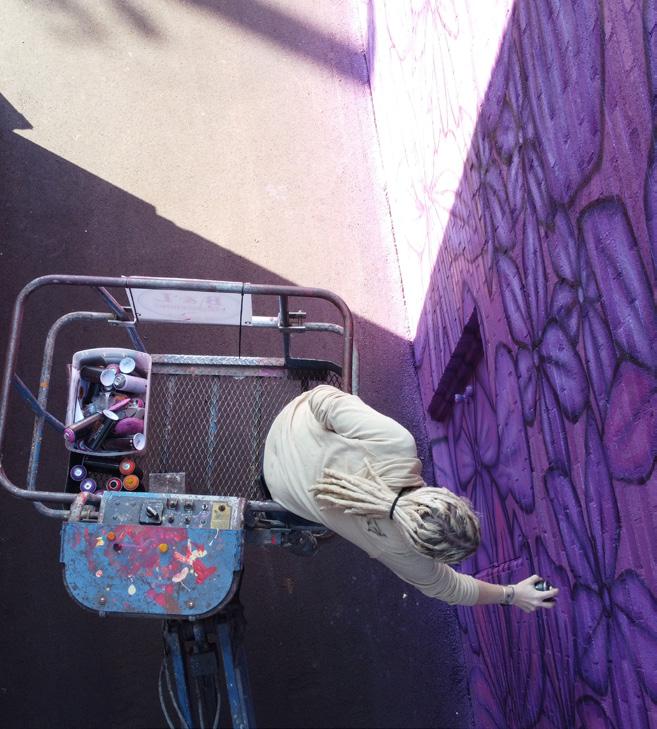
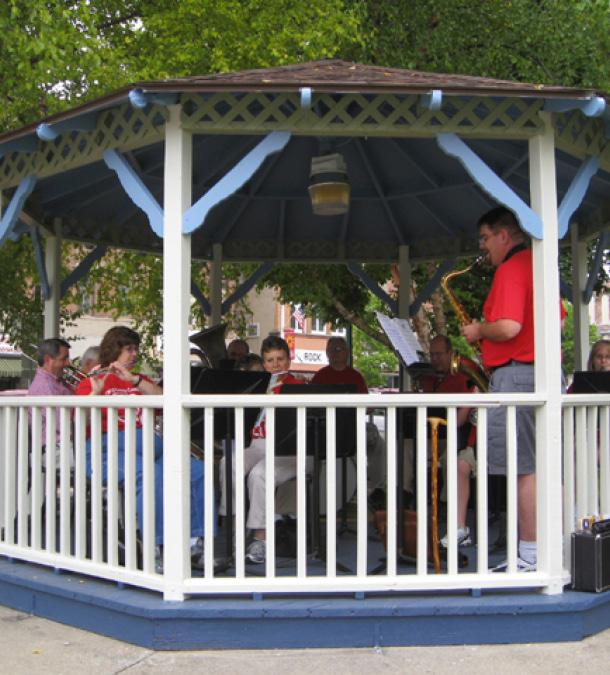


Throughout the planning process, engagement was conducted to help identify and assess existing resources and gaps and provide a foundation for transformative projects. The following methods of engagement were used to glean information from stakeholders and the general public.


Seven community workshops were held from May 19–22 in each of the seven counties in the GLRR. These workshops engaged over 80 interested members of the community and introduced people to to the plan and gathered feedback on the desired future of the arts.
Events
May 19 | White County: IU Health White Memorial Hospital
May 20 | Carroll County: Delphi Opera House Banquet Hall
May 20 | Montgomery County: Wabash College Trippet Hall Rm 123
May 21 | Fountain County: Fountain Co. Library - Covington
May 21 | Warren County: Warren Co. Learning Center
May 22 | Benton County: Fowler Theatre
May 22 | Tippecanoe County: Public Safety Building
What recent arts and culture offerings in the region have you been excited about?
Some of the most frequent experiences participants noted included:
▪ Wabash Walls
▪ Youth theater performances
▪ College music and theater performances
▪ Local libraries
▪ Public art opportunities and experiences
▪ Events at the Delphi Opera House
▪ Local festivals, such as the Hispanic Heritage Festival, Indiana Bacon Fest, Mosey, Taste of Tippecanoe, Star City Nights, Summer on the Square, 4th of July, and more.
Participants had the opportunity to mark locations on maps of their community and maps of the entire region. Results showed that while many participants were able to experience offerings in their own county, such as at small theaters and libraries, many traveled to Lafayette or Delphi to experience the arts.



Using post-its and discussions, people noted that arts and culture should feel:
▪ Accessible and Affordable
▪ Community-focused
▪ Diverse and Inclusive
▪ Exciting and Fun Needs and Opportunities
Discussions during and/or following the activities allowed for more in-depth analysis of barriers to access to and production of arts experiences. Some of these barriers included:
▪ Funding for the arts
▪ Marketing events and getting people to attend
▪ Physical access/transportation to arts programs
▪ Communication between arts organizations
▪ Space for performances, programs, and exhibits
A fund allocation activity was held where participants were able to use plastic coins to denote where their funding priorities were.


Virtual conversations were held with over 25 business owners, government officials, artists, and educators in the community. These conversations lasted 30-minutes to an hour and were held as 1-on-1 conversations or as focus groups. Stakeholders focused on their own communities, allowing for specific feedback on local needs that revealed consistent, regionwide patterns.
The stakeholder discussions on the Greater Lafayette Region Arts & Culture Plan revealed appreciation for the local arts scene and significant challenges and opportunities. Favorite arts experiences include local performances and annual events, with a recognized improvement in the overall arts scene, though some residents still travel to larger cities for diverse offerings. Key challenges include difficulties in marketing and audience engagement, particularly reaching diverse demographics and younger audiences; and the persistent issue of securing stable, competitive funding for arts organizations. Despite these hurdles, major opportunities exist in leveraging the arts for community revitalization, economic growth, enhanced quality of life, and educational enrichment. There's a strong desire for increased collaboration, unified marketing efforts, improved venues, and sustainable funding to fully realize the potential of arts and culture in the region.
▪ Audience Engagement. Challenges exist in attracting diverse audiences, particularly in the post-college demographic. There is a noted gap in programming for teenagers and middle school students, and a need for more inclusive spaces for specific communities (e.g., Hispanic and Latino).
▪ Funding and Financial Stability. Organizations struggle with broader funding challenges and the need for competitive wages to attract skilled professionals, which has been a longstanding issue. Many organizations rely on volunteer work and face financial vulnerability due to limited fundraising teams and losses of funding from key sources like the National Endowment for the Arts and Institute of Museum and Library Services (IMLS). There's a need for sustainable funding and a funding mechanism to ensure operational stability, especially in rural areas which often lack resources for administering arts programs.
▪ Marketing and Outreach. A decline in local media coverage and the complexities of social media algorithms hinder an organization’s ability to promote their events. There is a strong desire for a centralized resource or marketing platform to disseminate information about local events, as current methods are often ineffective and leave desired audiences out of the know.
▪ Venue Limits. The lack of suitable and flexible venues has limited the variety of performances and cultural events, and often leads residents to travel to larger cities for diverse experiences.
▪ Community Divides. Economic disparities, geographical divides (e.g., reluctance to cross the river between Lafayette and West Lafayette), and a strong sports focus in some communities can sideline the arts and affect participation in events.
▪ Volunteerism. There are concerns about the changing nature of volunteerism, with younger generations less likely to commit to unpaid work compared to older volunteers. This stretches the capacity for organizations to remain open and functioning with their limited budgets and resources.
What should arts and culture do for the region?
▪ Engage and Enhance Community Life
▪ Support Mental Health and Well-being
▪ Promote Learning and Self-Exploration
▪ Drive Community Prosperity and Economic Growth
▪ Bridge Divides and Foster Inclusivity
▪ Provide Diverse Experiences
▪ Support Education
▪ Revitalize Communities
The GLRR community survey was open from April–June 2025 and received 126 survey responses from the public. This survey was shared through stakeholder channels and social media outlets. It was one aspect of the planning process and responses were supplemented via in-person and stakeholder engagement.
What big ideas do you have for Arts & Culture in the region?
▪ Fostering a Decentralized and Supported Arts Ecosystem. There is a strong desire for investment in and utilization of existing small, intimate venues and local creators, direct support for artists (grants, affordable spaces, business education), and the creation of accessible, community-based arts centers. The core idea is to build from the ground up, empowering local talent and grassroots initiatives.
▪ Strategic and Contextual Public Art & Placemaking. There is a clear demand for more public art integrated into everyday spaces, not just designated areas. This art should tell local stories and contribute to the unique identity of the region. There is also an interest in impactful, largescale installations that command attention and create whimsical, memorable experiences.
▪ Enhancing Regional Connection and Cohesion through Arts. A prominent theme is the need to connect communities through physical and digital arts trails and corridors. This includes strong calls for cross-county collaboration, joint programming, resource sharing, and unified marketing efforts to promote the entire region as a cohesive arts destination. A centralized information hub is seen as crucial for this.
▪ Diversifying and Modernizing Arts Programming. There is a significant demand for more diverse live music and performance venues, new and engaging interactive art experiences, and participatory events. There’s also a push to embrace a wider range of artistic mediums beyond traditional forms, including digital art, culinary arts, and unique kinetic installations.
▪ Sustainable Infrastructure and Support for the Arts. This overarching idea emphasizes the critical need for long-term, stable funding for arts organizations, including endowment support. It also highlights the importance of bridging institutional gaps to ensure resources benefit the broader artistic community and a consistent focus on arts education and opportunities for all ages, particularly youth.
Arts & Culture in the region should feel…

The Arts & Culture Plan for the Greater Lafayette READI Region should accomplish the goal of :
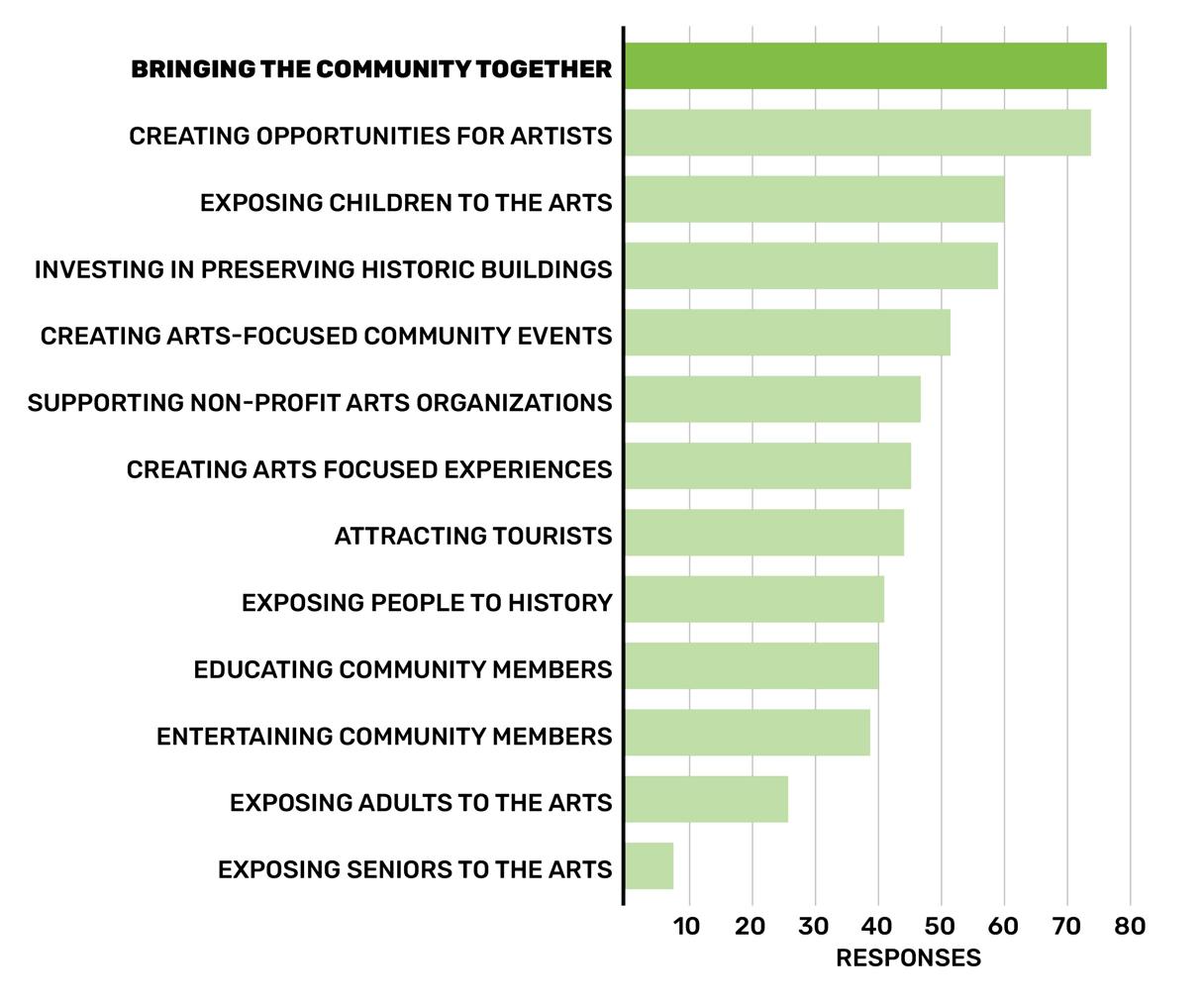
Which of these motivations for experiencing the Arts do you most strongly align with?

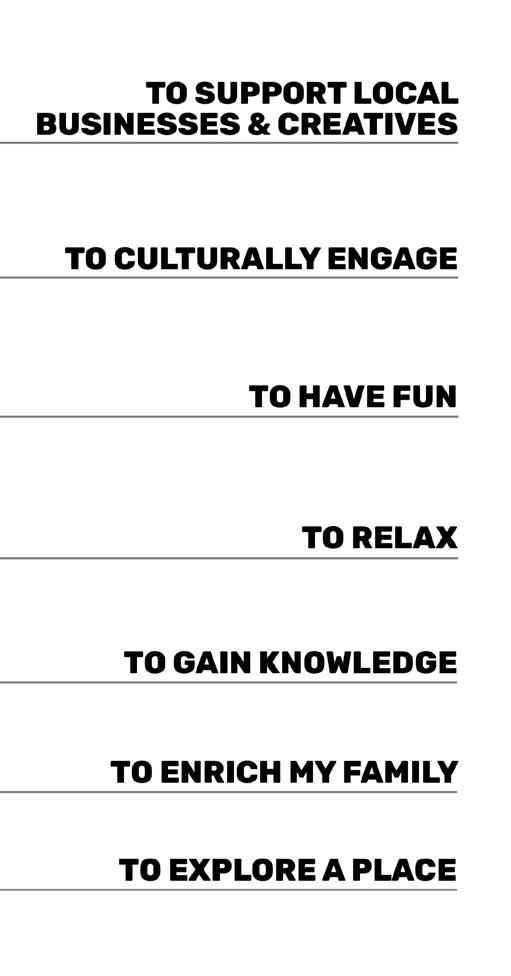
What impact should arts and culture have throughout your county / the region?

What three words or phrases would you use to describe your county / the region?

What is your relationship with the Arts (visual, literary, performing, etc.) in your county / the region?

Cities such as Lafayette (31), Delphi (16), and Fowler (14) received the most responses, but engagement spread across the seven counties.
What is your zipcode?

Throughout all engagement methods, the following takeaways emerged.
Arts and culture should be financially, physically, and socially accessible. Programming should reach all demographics and communities to be something that everyone can enjoy.
Organizations should have clear strategies for how to reach broader audiences. Similarly, consumers should know where to look to find events in their community.
Organizations should have the funding needed to attract and retain skilled professionals needed to operate at full capacity. Funding is also necessary for producing desired programming and marketing to audiences.
There should be a wide variety of artistic mediums and interactive experiences for the community to enjoy. This comes with more flexible venues, and can help reduce the gaps in programming for younger audiences.
Public art should be integrated into everyday spaces and contribute to the identity of the region. Public art is an effective placemaking tool that can increase community pride and assist with beautification.
Arts and culture should be a catalyst for strengthening community bonds, enhancing quality of life, supporting mental health, and driving economic prosperity and revitalization.
Education should be offered to the community to quell skepticism and help communities understand the value and importance of the arts. It should be understood what the effects of arts are and can be to establish them as a necessity in all communities rather than a luxury.
The Greater Lafayette READI Region is home to a vibrant, accessible, and inclusive arts and culture ecosystem. In all corners of the region, the arts economically enrich communities while strengthening relationships and enhancing personal well-being.
Increase visibility of arts and culture resources and opportunities
Develop arts and culture programs that are accessible and inclusive to all
Foster and leverage local arts and culture amenities.

Long-range planning for cultural investment means that oftentimes plans may feel of ‘an era’, when certain financial conditions or structures inform plan outcomes that might span more than a decade, yet no longer feel as relevant or as visionary as they once were. The flexibility provided in this framework creates opportunities for decision-makers to pursue diverse funding sources and pivot implementation priorities to take advantage of changes and growth in the local cultural ecosystem. It also allows the community to continue to dream big, yet places emphasis on actionable, momentum-building steps for growing local arts and culture assets and tackle them as additional funding and capacity becomes available.
Each objective is accompanied by strategies to support the objective, timing, personnel requirements, impact, and relative impact, when appropriate.
The timing for each strategy has been defined as:
▪ Short: 0 to 3 years
▪ Mid: 3 to 5 years
▪ Long: 5+ years
Personnel requirement has been defined as:
▪ Project owner(s) who will manage and drive recommendations
▪ Partner(s) who will support the project owner(s)
Investment has been defined as:
▪ $: $0 to $250,000
▪ $$: $250,000 to $1 million
▪ $$$: $1 million+
▪ Foundational. Foundational impact strategies are essential to the long-term health and sustainability of the region’s cultural sector but may go unnoticed by the community-at-large.
▪ Targeted. Targeted impact strategies will improve the resident experience at the individual level.
▪ Transformational. Transformational impact strategies will fill a significant gap in the market; set the foundation for new programs, projects, or practices; or directly shift the general perception of the region as an arts and cultural community (e.g. through visible interventions like placemaking and public art).
Regional strategies are recommendations that should affect and be implemented at a regional level. These strategies should be overseen if not managed by The Arts Federation (TAF), and are intended to develop a cohesive and supported arts and culture community across the GLRR’s seven counties.
1.1 Promote The Arts Federation (TAF) as a resource for public art and technical assistance.
GOALS
TIMING short
OWNER/PARTNERS
TAF, local government,arts leaders and organizations, GLRR
INVESTMENT
$
IMPACT foundational
The Arts Federation (TAF) is an arts organization and council overseeing 14 counties in the West Central region of Indiana. TAF provides educational opportunities, outreach programs, and funding for the arts. TAF offers arts programming, workshops, events, and awards grants to nonprofit community and cultural organizations. With its expansive reach and expertise, TAF is positioned to support the region’s creatives and artists in an impactful way. As the GLRR continues to grow and develop its arts and culture sector, TAF should be tapped as a critical partner in supporting individuals in creative fields through programming, grant assistance, technical support, and beyond.
ACTION STEPS
1. Develop a media package outlining the TAF’s role and available resources and distribute it to local partners
2. Build a presence in regional localities through in-person interactions and organizational support

GOALS
TIMING
short
OWNER/PARTNERS
local government, TAF, community foundations, higher education institutions, business and industry, arts and cultural organizations, GLRR
INVESTMENT
$
IMPACT
targeted
Not all community members have bought into the idea that investments in art and culture are worthwhile, particularly given the prevalence of other community needs. Demonstrating the value of these investments, and how they can be part of the solution to local issues, can beget more support for them over time. This will require an ongoing process of sharing stories about the impact of art and culture on local people and actively involving them in the creation and enjoyment of creative projects.
ACTION STEPS
1. Create a media plan for each public art and major cultural project that includes follow-up stories about its economic, social, educational and/or other community benefits.
2. Offer periodic participatory art projects that invite community members of all ages to co-create the pieces.

GOALS
TIMING
short
OWNER/PARTNERS
TAF, local organizations, local government, GLRR
INVESTMENT
$
IMPACT
targeted
The GLRR is home to many individuals and organizations working to bring arts and culture into their communities. Regular and dynamic artist mixers are an effective way to develop and connect the region’s network of creatives and artists, generate buzz around upcoming local events and experiences, and provide opportunities to share knowledge and resources. These events could vary in scale and topic and could rotate host sites to maximize reach across the GLRR region.
1. Develop a list of all arts organizations in the region.
2. Create a set schedule for region-sponsored and hosted gatherings of the organizations on this list.
3. Encourage similar events at the County level where possible.
4. Host the gatherings.
Tippecanoe County
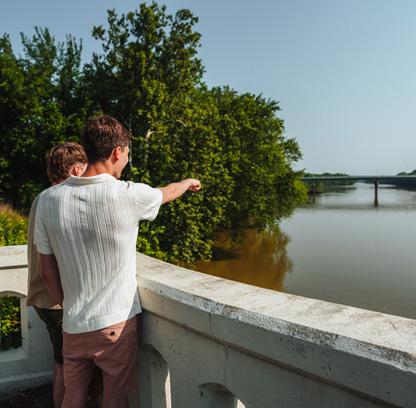
1.4 Include arts and culture as an element of riverfront expansion and greenway trail projects along the Wabash River.
GOALS
TIMING
mid
OWNER/PARTNERS
project managers, GLRR, TAF, local government
INVESTMENT
$$
IMPACT
transformational
The Wabash River is a valuable natural and recreational resource that stretches through the GLRR. Multiple largescale and overlapping riverfront revitalization projects are occurring in and around the region, each with their respective scopes, budgets, and funding streams. While each provides their own intention for their segment of the riverfront, an intentional public art strategy for the riverfront could celebrate the area’s natural beauty and unite the region across county and city boundaries. Arts and culture is a great method for beautification, but also for enticing people to come and explore a place. As the GLRR continues to invest in its riverfronts, public art could focus on regional history and local narratives and transform the riverfront into a natural destination for locals and tourists alike.
ACTION STEPS
1. Communicate with project owners and implementers of the various expansion efforts happening across the region
2. Participate in planning processes for riverfront development where possible
3. Provide resources (i.e., knowledge, artist contacts) for arts inclusion in development efforts
Within Indiana, the Wabash River stretches from Mt. Vernon in the southwest through Berne in the northeast, passing through Covington, Attica, Lafayette and West Lafayette, and Carroll County. As a major source of resources and entertainment, several efforts have been and are being conducted across the river’s path to expand access to the riverfront to communities impacted by it. The Wabash River Heritage Corridor is overseen by the Wabash River Heritage Corridor Commission, who work to protect and enhance the natural, cultural, historical, and recreational resources and encourage sustainable development of the corridor.
In the GLRR, efforts have been going on for over a decade to extend the reach of the waterfront, especially through urban areas such as Lafayette and West Lafayette (Two Cities, One River (2011), Wabash River central Reach (2017)). Some of the current projects happening regionally include:
Wabash River Blueway Master Plan (2024). Fountain, Vermillion, and Warren Counties
Partners: Kimely-Horn, Warren County Community Foundation, Western Indiana Community Foundation
Completed in 2024, this tri-county plan, two of which are in the Greater Lafayette READI Region, recommends improved boat and pedestrian access, programming such as festivals and tours, and art installations along the riverfront. The plan intends to promote an increased quality of life within the three counties and attract new residents through outdoor recreation along the waterway. The project is supported by a grant from the Lilly Endowment, a considerable portion of which is dedicated specifically to public art.
Wabash River Greenway Plan (TBR). Cass, Carroll, Fountain, Tippecanoe, and Warren Counties
Partners: Wabash River Enhancement Corporation (WREC)
After receiving a grant from the Wabash Heartland Innovation Network (WHIN), WREC began planning a multi-use trail spanning five counties along the Wabash River. When realized, this opportunity will
• create a nationally significant quality of life recreational resource within the largest watershed of the state
• become an economic development driver for new public and private investment
• utilize technology to enhance the user experience
• restore the riparian corridor ecology as the premier river system of the Midwest. The plan is not yet published (as of August 2025), but has already spurred successful grant applications throughout its 5-county study area.

GOALS
TIMING
mid
OWNER/PARTNERS
local organizations, local government, TAF, Convention and Visitor Bureaus, GLRR
INVESTMENT
$$
IMPACT
transformational
Marketing is a necessary and time-consuming process that arts and culture organizations need to do successfully if they want to be sustainable and attract audiences. There are many channels of communication that people need to use, and it is difficult to know what is best, either for promoting or discovering experiences. Organizing an intentional, comprehensive, and easy-to-navigate method of marketing and communication at the regional level could help ease these struggles for both organizations and residents.
ACTION STEPS
1. Consolidate current iterations of event promoters and marketers and audit how they are contributed to.
2. Create a strategy to organize how cultural organizations can ensure their promotion on the platforms.

GOALS
TIMING
mid
OWNER/PARTNERS
festival coordinators, local government, TAF, GLRR
INVESTMENT
$$
IMPACT
transformational
Cultural events and festivals are an effective way to engage neighbors and tourists alike. With many current signature festivals drawing in hundreds of thousands of attendees, opportunities should be considered for expanding these programs to longer iterations, when possible), as well as smaller localities and satellite installations. This regional focus would widen the accessibility for audiences who might otherwise be unable to participate in community cultural events. Additionally, potential for partnerships and sponsorships between signature events and local events with similar goals should be explored to bring more attention to both operations.
1. Extend one-day festivals to full weekends (Saturday and Sunday, Friday when feasible)
2. Look for opportunities to extend satellite festival programming in one-day/pop-up installations in other parts of the region and other times of the year
3. Work with local festivals to assess opportunities for future collaboration/sponsorship
County strategies should be implemented at the county level, supporting more localized arts and culture efforts to build stronger communities. When applied throughout the region at this level, the wider arts and culture community will have reliable support in place and a breadth of opportunities for working in and experiencing what there is to offer.

GOALS
TIMING
short
OWNER/PARTNERS
In many communities throughout the GLRR, the local libraries are a primary source of arts and culture events and programming. In order to sustainably elevate available programs offered, allowing for and supporting collaboration between the libraries should be pursued. This intentional partnership would support scheduling in a way that doesn’t overlap or conflict with certain efforts branch by branch. Additionally, libraries could pull missions together in a way that encourages additional funding and grant opportunities.
county libraries, TAF, local government, GLRR
INVESTMENT
$
IMPACT
targeted
ACTION STEPS
1. Assess interest in participating in resources sharing, etc. from local libraries
2. Meet regularly with library leaders to encourage collaboration

GOALS
TIMING
mid
OWNER/PARTNERS
TAF, local organizations, community foundations, local government, GLRR
INVESTMENT
$$
IMPACT
transformational
One of the largest and most frequently stated barriers to experiencing local arts and culture programs is transportation. Prospective audiences in rural and urban areas alike struggle with being able to get to and from events without a car. Transportation options would allow programs to reach new and broader audiences. There are many different options that should be explored and tailored to specific organizational needs and capabilities.
1. Assess current transportation methods for opportunities for program expansion/partnerships
2. Determine methods of transportation that work for your community.
Examples of transit programs include but are not limited to:
▪ Cultural Loops. Bus or similar vehicle travels in a consistent route that stops at areas of cultural interest, i.e., performance venues, museums, libraries
▪ City/County Transportation. Adjust routes of municipal transit to allow for better access to cultural experiences
▪ Temporary Interventions. Bus or similar vehicle transports people from a pick-up point to an event or experience and back
▪ Local Partnerships. Share a vehicle/transit service with a local organization, i.e., religious institution, to use outside of their operating hours

approach to public art planning that conducts local public art plans to organize and maximize public art efforts.
GOALS
TIMING
local
OWNER/PARTNERS
local government, TAF, GLRR
INVESTMENT
$ IMPACT
targeted
The GLRR has an ever-growing wealth of public art that yields many benefits for residents and visitors alike. Public art that feels authentic to each individual community will emerge from individualized planning processes at the municipal level. Cities across the region may be interested in pursuing long-term planning for public art or are curious about policy and funding strategies to support public art, given community feedback throughout this planning process. An investment in public art enhances quality of life, enlivens public spaces, and expresses a community’s unique story.
ACTION STEPS
1. Write and post an RFP from qualified public art planners
2. Facilitate and develop a public art plan
Montgomery County

TIMING
short
OWNER/PARTNERS
local government, TAF, community foundations, GLRR
INVESTMENT
$
IMPACT
foundational
In order to maintain and sustain momentum in public art, local policies should be implemented that allow for it to flourish. Public art programs can provide paths to implementation, regulations of costs, design, and scale; and sustainable funding sources. Developing policies locally ensures that programs are tailored to what works in a specific community. By definition, public art is paid for and maintained by a governing body (County, City, Town, etc.), and should be regulated by a series of ordinances or policies. Interested communities should establish public committees, or similar bodies, to oversee public art development, if they have not already done so. Supports could inlcude sample policies, ordinances, capacitybuilding, technical assistance, regional artist rosters, etc.
1. Adopt policy to govern a Public Art Program.
2. Evaluate the effectiveness of the adopted policy in 5 years to understand if any changes should be made.
3. Utilize TAF as a resource for information on recommended local public art policy, funding, commission structure, etc.
Counties/local governments should adopt the following policies to govern Public Art Programs (if they do not yet have a public art program established): Maintenance, Collection Management, Donation, and Mural Guidelines.
In order to establish a successful Public Art Program, the municipality will adopt a number of policies. The policies include a Collection Management Policy, Donation Policy, Maintenance Policy and Mural Guidelines. The aforementioned policies and guidelines will do the following:
• Establish a definition for public art;
• Develop a process for public art to be commissioned; and
• Establish a Public Art Committee to oversee Program duties and responsibilities.
Each policy directs a specific aspect of the Program and ensures the locality is following consistent procurement practices, maintaining its commissions through long-term planning and maintenance, governing the Program with strong public trust, and providing clear direction for artists, private developers, and donors to follow when participating in the Program.
This policy establishes the overall definitions contained within the policy.
This policy establishes the management practices of artworks acquired through the solicitation and donation processes. These pieces are considered part of the Locality’s Permanent Collection and must be cared for in accordance with the Policy and Procedure for Maintenance and the Collection Management Policy. The Collection Management Policy is intended to maintain the value of the Locality’s Permanent Collection and guard against inappropriate disposal of any of its pieces.
This policy establishes the donation process for artworks not commissioned by the locality. Each proposed donation must come with a plan to fund and deliver ongoing maintenance, or the resolution accepting the public art must identify how maintenance of the donated public art will be funded. Donation requirements, responsibilities of the donating party, and the process for donating a piece of public art are outlined in this policy.
This policy establishes the procedure for maintenance of the future art collection. Direction for surveying the collection, working with future artists to establish a maintenance plan for any commissioned work, and inspection guidelines are included.
In order to achieve the region’s vision for public art, sustainable funding is a necessary first step. There are many options for funding a municipal Public Art Program and several factors are considered when determining the best mechanism for a community.
The local governing body should allocate 1% of its capital improvement budget to public art. This funding stream will guarantee funding for public art projects regardless of economic events that cause constrictions in funding projects. This policy also guarantees that public art projects are planned for and executed annually as long as Capital Improvement Projects (CIP) are underway and municipal construction continues.
The allocation for all projects should be calculated based on the total construction costs, excluding all costs for demolition and real property acquisition for any given capital project. In addition, the appropriation for public art should be calculated only on the original appropriation for design and construction services, excluding any amounts appropriated for change orders.
A public art allocation should not be made for road maintenance, underground infrastructure, and underground utility projects with no aboveground components other than roads. When there are utility projects with aboveground components that are visible, a donation toward public art should be considered.
Wabash Walls is a project through TAF to implement public art throughout their 14-county service area. TAF recognizes the value of public art in the quality of life throughout North Central Indiana. Wabash Walls is a collaborative educational outreach program that serves the quality of life of underserved individuals and communities.
Initially piloted in Lafayette to reduce vandalism, Wabash Walls now boasts over 100 murals created by artists from around the globe. This program has successfully united the region and made this part of Indiana an arts destination. The success of the program is centered around partnering local community members with artists to develop theme, content, and subject matter that is specific to that population.
This region-wide public art project features murals developed, executed, and installed in counties served by The Arts Federation. Wabash Walls aims to increase county and regional vitality.
The implementation of this project in each county
1. removes blight;
2. creates tourist destinations;
3. increases property values in adjacent areas;
4. provides community pride and ownership;
5. improves quality of life; and
6. increases workforce retention.
Each mural is featured in a prominent county location and residents of each community develop themes and select their respective artworks and artists.
In addition to community-specific murals, Wabash Walls presents an annual mural festival that is recognized as the first mural festival to take place in the state of Indiana. Artists from around the globe have contributed their talents to the program.
wabashwalls.theartsfederation.org




W – Jenna Morello
A – Cameron Moberg (Camer1)
B – Nicole Holderbaum (Nico)
A – Zach Medler (ZMED)
S – Aaron Vickery (Fasm)
H – Cameron Moberg (Camer1)
W – Ella V
A – Jeff Guichelaar (Geoff)
L – Nicole Holderbaum (Nico)
L – Andres Cobre
S – Zach Medler (ZMED)
! – Bekki Canine


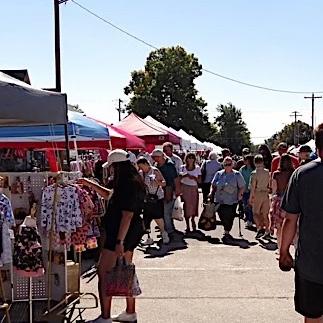
GOALS
TIMING
mid
OWNER/PARTNERS
TAF, local government, higher education cultural centers, community foundations, GLRR
INVESTMENT
$$
IMPACT
transformational
Signature cultural festivals in the GLRR should highlight the unique spirit, traits, and histories of the distinct communities that comprise the region. Distributing these events throughout the year will ensure a consistent programmatic experience that promises events that feel fresh and timely. Leveraging higher education entities, such as Purdue and Wabash College, as well as the GLRR’s diverse international community (businesses/industry), and historical organizations, would offer new an exciting opportunities to engage new audiences and create representative programming. Additionally, a series of signature festivals encourages visitorship and tourism into host communities, spurring the local economy and drawing increased foot traffic to local businesses. Festivals developed should not detract from the established catalogue of existing festivals and events, instead complementing them and filling gaps surrounding them.
1. Work with local local governments to identify prime markets to engage that celebrate unique local experiences
2. Assist with the creation of local festivals through resource allocation, knowledge sharing, technical assistance, and funding (when appropriate)

mid
Downtowns across the region are hubs for arts and culture in their communities. General placemaking efforts in these areas (including lighting, plantings, seating, park space, public art, etc.) provide more user-friendly experiences that invite people to spend more time in their communities. Many of the GLRR’s downtowns are historic resources that already provide a unique feel to the streetscape that should be invested in and enhanced through beautification of their surroundings.
local government, TAF, local organizations, community foundations, GLRR
INVESTMENT
$$
IMPACT
transformational
1. Identify a funding source for art investments in downtowns throughout the region. TAF could invest in a pilot project in which the execution of one round of temporary projects was funded to gauge the success of the investment.
2. Develop a plan for executing the temporary public art investment including a timeline for an RFQ release, allowable locations for placement of art, duration of installation, maintenance guidelines for work, and any additional programming surrounding the installation.
3. Execute the installation of the artwork.
Many downtowns in the state already feature Artist Alleys that display local art and provide exciting instances of placemaking. This initiative should be expanded across the GLRR, making downtowns unique and instilling community pride.
Facility strategies should be implemented by specific facility owners/managers, where possible. These are institutions/facility types that host local arts and culture experiences that the community should be able to continue to widely enjoy.

GOALS
TIMING short
OWNER/PARTNERS
local government, GLRR
INVESTMENT
$
IMPACT foundational
An audit should be conducted to assess GLRR communities’ current facilities, to the extent possible, to understand what programs are being offered in what facilities and what the market desire is for programming across facilities. Outcomes from this assessment should be used to determine if and where additional facilities and programming should be created.
ACTION STEPS
1. An audit of arts and culture programming should consider:
▪ Classes offered, with capacity and actual numbers
▪ Demographics of attendees
▪ Class attendance and demand
▪ Cost recovery requirements by facility
▪ Ticket sales and event demand (if applicable)
2. Conduct an audit, to the extent possible, of private arts and culture classes in the region to identify trends and gaps.
3. Determine whether additional facilities are necessary to support community demand or if increased frequency within existing facilities would suffice.

GOALS
TIMING
long
OWNER/PARTNERS
local organizations, community foundations, local government, developers, GLRR
INVESTMENT
$-$$$
IMPACT
transformational
The GLRR is home to many historic buildings and assets that are unique staples of arts and culture in their community. Museums, performance spaces, and similar facility types in historic spaces provide desirable audience experiences and create iconic landmarks. Investing in the revitalization of atrisk buildings and places yields many positive community benefits, including increased property value, heritage tourism, affordable rents for local businesses, and an increased sense of local pride. While no two preservation projects unfold in the same manner, exploring various investment and use scenarios for underused, at-risk buildings can ensure that communities achieve their desired outcomes for their historic downtowns.
1. Assess necessary renovations to maintain facility operations
2. Assess renovations required for historic preservation, through an effort such as a historic preservation plan
3. Conduct a capital campaign to support the project
4. Identify additional funding sources for the development and operations of the facility as needed

GOALS
TIMING
long
OWNER/PARTNERS
local organizations, local government, community foundations, developers
INVESTMENT
$-$$$
IMPACT
transformational
Many organizations within the GLRR are growing and/or have outgrown their current facilities, and are no longer able to provide the scale of programming they would otherwise be able to. These institutions should explore creating new spaces to expand into, or retrofitting existing facilities where possible. It is important for audience attraction that organizations are appropriately scaled to their available programs and capacities. When feasible, assistance and support for grants, permitting, and building assessment should be offered.
ACTION STEPS
1. Conduct a feasibility study to determine the space/type of facility required.
2. Determine if an existing facility the organization can acquire suits its needs, or if new construction is required
3. Conduct a capital campaign to support the project
4. Identify additional funding sources for the development and operations of the facility as needed
5. Work through the appropriate channels to secure permits for construction and programming
6. Assess new staff required to operate the facility
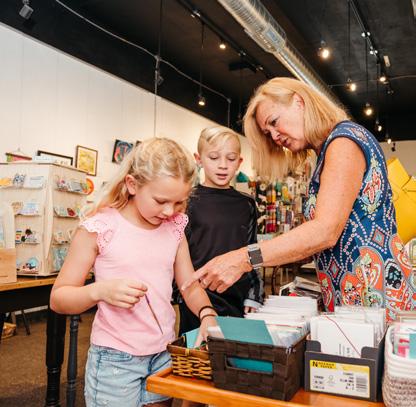
TIMING
short
OWNER/PARTNERS
3.4 Create and promote local arts programs for all ages that encourage the region to participate in arts and culture, utilizing local institutions and organizations.
local organizations, TAF, community foundations, GLRR, higher education institutions, local parks and recreation departments
INVESTMENT
$
IMPACT
targeted
Exposure to arts and culture of all kinds is beneficial to all members of a community. Opportunities for engagement in the arts are invaluable to everyone from youth during their formative years to older adults looking for enrichment and community. These kinds of programs could emerge through strategic partnerships between regional or local agencies and arts and culture organizations around the GLRR. Programming offerings should be scaled appropriately for all age groups; for example, programs for school-aged children should emphasize opportunities around discovering various art forms and connecting with other cultures, while experiences for young adults should offer young career readiness or extracurricular engagement.
ACTION STEPS
1. Identify organizations that are able to partner with Regional and County entities for arts education opportunities
2. Assess capacity for operating educational arts and culture programs at the local level.
3. Establish a consistent schedule of classes for the community.

Securing financial support for arts and culture initiatives in the Greater Lafayette READI Region requires a multi-pronged approach, exploring opportunities at the state, regional, and local levels, as well as from private sources. It should be noted that as national and state funding cuts impact available funding, local tools should be explored in the short term as the most viable solution for funding arts and culture initiatives.
The Indiana Arts Commission (IAC) is the primary state agency for arts funding, and they offer several grant programs. The IAC works through Regional Arts Partners across the state to administer some of its programs and provide local guidance. Key opportunities include:
Arts Organization Support: This opportunity provides annual operating support to eligible arts non-profits.
Arts Project Support: This opportunity provides funding to nonprofits, governments, and schools for specific arts-related projects, events, exhibitions, or workshops.
Arts Midwest is a regional organization that serves Indiana and other Midwestern states, offering grants and programs that support touring artists, creative projects, and community engagement with the arts.
Indiana Humanities often supports cultural programs with a humanities focus, including those that intersect with artistic expression and storytelling.
The Indiana Arts Commission has several regional partners that promote and expand participation in the arts in Indiana. The partners provide broad regional access to arts services and funding opportunities and provide services that include, but are not limited to, grant making and information and referral. The Arts Federation is the IAC designated Regional Arts Partner serving all of the counties of GLRR.
Local government investment in arts and culture is crucial to realizing the community’s vision for the future. A diverse range of options is outlined below and should be considered by each governmental partner, as each proposed solution will not be a fit for every community. By leveraging direct appropriations, dedicated revenue streams, policy frameworks, and publicprivate partnerships, local governments can generate substantial measurable funding streams and high-impact economic benefits.
One of the most common and fundamental ways governments participate in arts and culture funding is through direct allocations from their general operating budgets, which are then distributed as grants to support arts organizations and cultural programs. This approach typically involves a dedicated local arts agency or a specific department responsible for administering these funds. Local Arts Agencies generally receive funds directly from local government expenditures and are tasked with distributing these grants to artists and cultural organizations across their jurisdictions.
The establishment of special tax districts represents a highly effective strategy for generating substantial and consistent funding for arts and culture. These districts typically impose a specified tax level, often for a fixed period, on particular goods and services within a defined geographic area. Such initiatives generally require authorization at the state level and, crucially, voter approval, which lends them significant public legitimacy and long-term stability. Once established, these districts are often administered by independent governing bodies, ensuring dedicated oversight and allocation of funds. These tax districts should be explored where there is significant community buy-in to the projects within each district and where there is economic advantage to a large number of small businesses and local partners.
Percent for Art ordinances are local government policies that legally mandate a specific percentage of the total budget for capital improvement projects to be set aside for public art. These policies ensure that art is integrated into the urban fabric and public spaces as a consistent feature of civic development.
Taxes are the primary revenue sources for local governments. The two largest tax types by revenue are property taxes and local income taxes. Although Indiana is a home rule state for ordinance enforcement, it is not a home rule state for taxation. Only taxes explicitly authorized by statute may be implemented by local governments.
Property taxes are the largest revenue source for local governments. Indiana’s property tax system is controlled by property tax levy. Each unit has a maximum permissible tax levy, set by a statutory formula, that they may levy on property in their jurisdiction. The levy is the amount of money to be collected and it creates the tax rate. The normal property tax rate formula is (Property Tax Levy)/(Net Assessed Value)*100. This amount will be reduced by applicable tax credits, especially the property tax caps and the supplemental homestead tax credit.
TIF is an economic development financing tool that allows local governments to capture incremental property tax revenue generated by economic development projects to finance the debt that paid for those projects and to reinvest in new economic development projects. If an area is designated as a TIF allocation area, the existing property tax base continues to be allocated to all taxing units but all assessed value growth attributable to physical improvements or new personal property is only taxed by the municipality that created the TIF to finance the public improvements that made the development possible.
TIF is the most effective and flexible economic development tool for local governments and is used on most significant new developments you see throughout the state.
Indiana currently sets local income taxes at the county level. A single county adopting body, either the county council or a local income tax council made of the county government and all of the localities in the county, determine the tax rate. The rate can be set up to 2.5% for expenditure rate, which generates additional revenue, and up to 1.25% for property tax relief, which funds property tax credits in the county. Expenditure rate revenue is usually distributed to all of the taxing units in the county that levy property taxes other than schools proportionally based on each unit’s share of the tax levy. The exception to this is the public safety rate, which is distributed only to units that provide police or fire protection, and the county carveout rates for specific purposes like the 911 system, county hospitals, county jails, or county court services.
Starting in 2028, the Indiana local income tax system is changing so that all cities and towns with a population of 3,500 or higher can adopt their own local income tax rate only on their own citizens without county approval with the county council remaining the adopting body for the income tax rate for all other units in the county, including the localities with populations under 3,500.
Local governments can issue general obligation bonds, debt backed by property taxes, to finance public projects. Units may levy additional property taxes outside of the normal levy limits to support their general obligation debt. The constitution and state statute limit the total amount of general obligation debt to 1/3 of 2% of the net assessed value in your jurisdiction.
Counties and local governments can adopt wheel and vehicle excise taxes to fund road projects in their jurisdictions. These taxes are collected on annual vehicle registration as renewal fees. The wheel tax is charged on commercial vehicles while the Vehicle Excise Tax is charged on passenger vehicles, but they must be adopted concurrently.
The wheel tax can be set at between $5 and $40 for each different commercial vehicle class while the Vehicle Excise Tax can be set at between $7.50 and $25 dollars for each passenger vehicle class.
Indiana code allows any county to adopt a lodging tax of up to 5 percent, with the tax being used for local tourism development and promotions. Some counties have a higher percent and they are either under their own legislation or have sought special dispensation from the Indiana General Assembly.
Authorized by a County Council, the Uniform Innkeepers Tax code establishes a local tourism authority appointed by various entities within the county to oversee its usage. These tourism commissions are sworn representatives of the community and must act in good faith to use these appropriations as stipulated in the tax code.
There is no general statutory authority for food and beverage taxes. Each is created by a specific state statute for a specific county or municipality. They are usually set at 1% but there are some as high as 2%. They are charged on restaurants and collected as sales taxes. They are dedicated to specific projects or uses designated by the enabling statute, usually for specific economic development projects. All food and beverage taxes have a sunset of no more than 25 years.
There are several statutes where governments can collect payments in Lieu of Taxes, or PILOTs, as an additional revenue source. These are payments that are voluntarily agreed to by otherwise tax exempt property owners for up to what their property tax liability would have been but for their tax exempt status. The most common form of PILOT is on tax exempt municipal utility property, but other forms exist.
Local governments have home rule authority to charge many different fees for the services they provide and penalties for violating local ordinances.
Local Governments may charge reasonable permit fees for municipally controlled permitted activities, like building permits or right-of-way access. They can also charge reasonable fees (with statutory maximums) for ordinance violations.
There are many user fees that can be charged for municipal services including trash fees, stormwater fees, park fees, etc. Local governments have broad home rule authority over user fee rates.
Impact fees are charged on new development to help defray the cost of necessary public improvements, like roads or parks, necessitated by the new development. Local governments have broad home rule authority over the impact fee rates.
The state government provides many transfers of funding from various revenue sources to local governments for specific purposes.
The commercial vehicle excise tax was taken over by the state many years ago and a portion of the revenue is still transferred to local governments.
Financial institutions are exempt from ordinary business taxation and instead pay the financial institutions tax. Local governments receive a portion of the revenue.
Motor Vehicle Highway (MVH) and Local Road and Street (LRS)
The Motor Vehicle Highway (MVH) and Local Road and Street (LRS) funds are statewide road funding sources funded primarily by the gas tax and gas sales tax. Local units receive distributions from both of these funds earmarked specifically for road funding based on a combination of their population and center lane road miles.
The community crossings matching grant program is funded by gas sales taxes and supplemental vehicle registration fees. This is a matching grant program for specific road projects that can be applied for annually, up to $1M, with local matching requirements of between 20%-50% based on community size.
There are other state grant programs and transfers available to local governments, but the major revenue sources are described above.
Despite the recognized value, rural communities often struggle to translate arts and culture plans into actionable initiatives due to inherent resource limitations. These areas frequently lack dedicated economic development organizations, cannot afford professional grant writers or lobbyists, and are disproportionately underserved by philanthropy. Technical assistance is therefore essential to bridge this implementation gap, providing the expertise, tools, and networks necessary for constituents to effectively execute their plans and access available resources.
Despite the challenges, rural communities possess inherent strengths that can be leveraged to foster vibrant arts and culture sectors.
Community Cohesion and Tight-Knit Networks: Rural communities are often characterized by strong social capital and tight-knit relationships. This inherent characteristic can be a powerful tool for increasing access to arts and arts education by fostering collaboration and shared purpose, as seen in successful community-focused practices.
Unique Cultural Assets and Identity: Rural areas frequently boast distinct cultural heritage, traditions, and local stories. These unique assets can be celebrated and leveraged through arts initiatives, fostering a strong sense of pride of place and attracting visitors seeking authentic cultural experiences.
Entrepreneurial Spirit: Arts and creativity foster the entrepreneurial spirit, which is crucial for rural communities to survive and thrive. Many small businesses are based on the arts, and many others rely upon the creative skills honed by arts and creativity, contributing to local economic diversification.
Direct capacity building focuses on equipping constituents with specific skills and knowledge needed to plan, fund, and implement arts and culture initiatives.
Mentorship and One-on-One Consulting: Providing tailored, individualized support is crucial for organizations that may lack in-house expertise or face unique, context-specific challenges. This direct, bespoke approach effectively addresses the identified capacity gap, offering practical solutions that are difficult to achieve through generalized resources. Examples include the Indiana Arts Commission's "Creative Convergence," which offers 50 hours of consulting support to rural communities for developing creative placemaking strategies. TAF also provides these workshops on a quarterly basis as a component of their technical assistance services.
Specialized Workshops and Training: Offering structured learning opportunities in critical areas will help build fundamental skills. The following key topics should be considered:
Grant Writing and Fundraising: Essential for navigating the complex funding landscape and overcoming rural funding disparities.
Financial Management and Diversifying Revenue: Training on earned income strategies, modern membership models, and building sustainable endowments, moving beyond sole reliance on traditional grants.
Legal Matters: Understanding business structures, contracts, copyright, and navigating municipal regulations specific to arts projects.
Marketing and Audience Development: Building brand identity, leveraging digital marketing tools, and effective community engagement strategies.
Project Management: Practical steps for defining, planning, organizing, and completing creative projects efficiently.
Impact Measurement and Evaluation: Developing frameworks to quantify social, educational, and economic contributions to strengthen funding cases and demonstrate value. Workshops should be designed for maximum accessibility, utilizing virtual formats where appropriate, offering sliding scale fees, and using clear, actionable language.
Fostering networks and peer learning environments is essential for sharing knowledge, building collective capacity, and addressing the isolation often experienced in more rural places.
Facilitating Regional Collaboratives and Peer Exchanges: Connecting leaders in creative communities enables them to learn from one another and leverage collective resources. This approach promotes sustainable growth by empowering local leaders to learn from and support one another.
Cross-sector convenings: Bringing together diverse stakeholders—including artists, arts organizations, community and economic development leaders, government officials, mental health professionals, and social service providers—is vital. This approach considers how the arts can be strategically leveraged as an interdisciplinary tool for broader community development. This meetup will also allow the identification, building, and sustaining of these cross-sector partnerships, aligning arts goals with other critical municipal and community priorities to achieve synergistic outcomes and unlock new resources.
